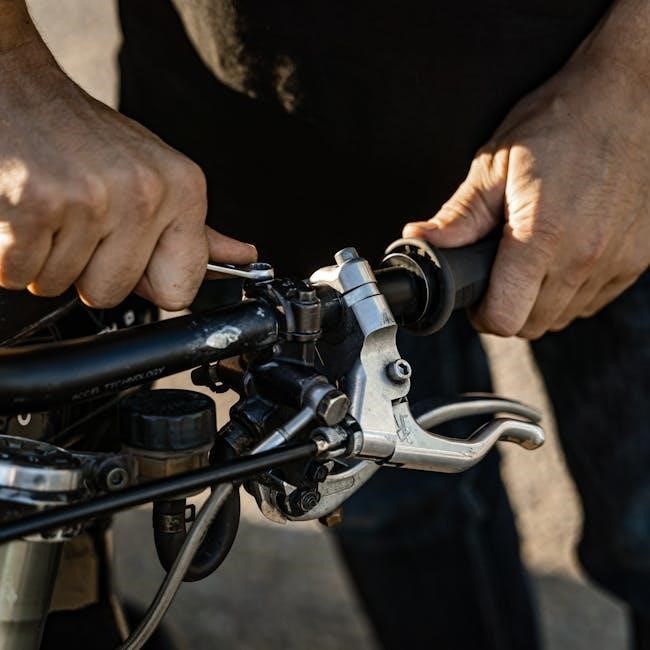This manual provides comprehensive maintenance procedures, inspection guidelines, and repair instructions for the Cessna 310Q aircraft, ensuring safety and compliance with FAA standards.
1.1 Overview of the Cessna 310Q Aircraft
The Cessna 310Q is a twin-engine aircraft known for its reliability and performance, suitable for both personal and commercial use. Produced from 1969 to 1974, it features a robust design and advanced avionics for its time. The model 310P thru 310Q series includes specific enhancements, such as improved fuel efficiency and a spacious cabin. With a comprehensive service manual, owners and mechanics can maintain optimal functionality. The manual covers routine inspections, engine overhauls, and system repairs, ensuring compliance with safety standards. Its detailed structure and clear instructions make it an essential resource for maintaining the aircraft’s airworthiness and extending its service life.
1.2 Purpose of the Service Manual
The Cessna 310Q Service Manual is designed to provide detailed maintenance procedures, inspection guidelines, and repair instructions for ensuring the aircraft’s airworthiness and optimal performance. It serves as a critical resource for aircraft mechanics, owners, and operators, offering step-by-step guidance for routine servicing, troubleshooting, and compliance with regulatory standards. The manual covers a wide range of topics, from engine overhauls to avionics maintenance, ensuring that all aspects of the aircraft are properly addressed. By following the manual’s instructions, users can maintain safety, extend the aircraft’s service life, and adhere to FAA regulations. It is an essential tool for anyone involved in the maintenance of the Cessna 310Q.
1.3 Key Features of the Cessna 310Q
The Cessna 310Q is renowned for its robust design, reliability, and performance capabilities. It features a sturdy airframe, powered by two Continental engines, ensuring exceptional speed and range for its class. The aircraft is equipped with a pressurized cabin, offering comfort for passengers, and a spacious interior. Advanced avionics systems enhance navigation and communication, while its fuel-efficient design makes it a popular choice for both private and commercial use. The 310Q also boasts a versatile landing gear system, enabling operation from various airstrips. These features, combined with its durability, make the Cessna 310Q a reliable workhorse in general aviation, suitable for diverse flying needs.

General Information
This section provides essential details about the Cessna 310Q, including model specifications, document structure, and safety guidelines, ensuring a comprehensive understanding for maintenance and operation.
2.1 Model Specifications (310P thru 310Q)
The Cessna 310Q, along with the 310P, features a twin-engine design with IO-470-U engines, producing 260 horsepower each. The aircraft accommodates up to six passengers and has a maximum takeoff weight of 5,500 lbs. The 310Q model introduced improved avionics and a higher maximum takeoff weight compared to earlier variants. Its range extends approximately 1,500 nautical miles, making it suitable for both personal and commercial use. The 310 series is known for its durability, performance, and reliability, with the Q model incorporating enhancements for better operational efficiency and pilot comfort. These specifications ensure the aircraft remains a popular choice for its versatility and capabilities.
2.2 Document Structure and Revision History
The Cessna 310Q Service Manual is organized into logical sections for easy navigation, ensuring clarity and accessibility. It begins with an introduction, followed by general information, maintenance schedules, and detailed procedures for engine, hydraulic, electrical, and airframe systems. The manual also includes sections on safety, legal compliance, and additional resources. Revision history is meticulously tracked, with updates documented by version number, release date, and a summary of changes. This ensures users always have the most current and accurate information. Revisions are based on feedback, technical advancements, and regulatory updates, making the manual a dynamic and reliable resource for maintenance professionals.
2.3 Safety Precautions and Guidelines
The Cessna 310Q Service Manual emphasizes strict adherence to safety protocols to ensure the well-being of personnel and the integrity of the aircraft. Always wear appropriate personal protective equipment, such as safety glasses and gloves, when performing maintenance. Ensure the aircraft is on level ground, brakes are applied, and the ignition is off before starting work. Use approved tools and follow proper lockout/tagout procedures for systems like electrical and hydraulic. Never bypass safety devices or skip pre-job safety checks. Refer to official Cessna guidelines and FAA regulations for specific precautions. Proper safety practices prevent accidents and ensure compliance with industry standards.

Maintenance Schedules
Maintenance schedules for the Cessna 310Q are designed to ensure aircraft airworthiness and safety. Routine tasks include daily pre-flight checks, 50-hour inspections, and 100-hour inspections. Annual inspections are mandatory, covering engine, fuel, and avionics systems. Adherence to these schedules ensures compliance with FAA regulations and prevents unexpected failures. Always refer to the official service manual for detailed checklists and intervals tailored to flight hours and operational conditions.
3.1 Routine Maintenance Requirements
Routine maintenance for the Cessna 310Q involves regular checks and tasks to ensure optimal performance and safety. Pre-flight inspections should include checking oil levels, tire pressures, and control surfaces. Every 50 hours, the engine oil and filter must be changed, and the air filter should be inspected. Additionally, the propeller and spinner should be checked for damage or wear. Battery maintenance, including charging and terminal cleaning, is recommended every 100 hours. These routine tasks, outlined in the service manual, help prevent issues and ensure compliance with FAA standards, maintaining the aircraft’s reliability and operational readiness for safe flight operations.
3.2 Inspection Intervals and Procedures
Inspection intervals for the Cessna 310Q are designed to ensure aircraft safety and longevity. Every 100 hours of flight time, a detailed inspection of the airframe, engine, and systems is required. This includes checking control surfaces for proper alignment, inspecting landing gear components for wear, and examining the engine for leaks or damage. Annual inspections involve a comprehensive review of all systems, including electrical, hydraulic, and avionics, to comply with FAA standards. Procedures must follow the manufacturer’s guidelines, using torque wrenches and precision tools to maintain accuracy. Regular inspections help identify potential issues early, ensuring the aircraft remains airworthy and operational.
3.3 Service Intervals for Optimal Performance
Regular servicing at specified intervals is crucial for maintaining the Cessna 310Q’s performance. Oil changes should be performed every 50 hours of flight time, with oil filters replaced at the same interval. Fuel injectors require cleaning every 100 hours to ensure proper fuel flow. Additionally, the hydraulic system should be serviced every 200 hours, including fluid replacement and component inspections. Adhering to these intervals prevents premature wear and enhances engine efficiency. Always follow the manufacturer’s recommendations to ensure optimal aircraft performance and safety. Proper servicing schedules help minimize downtime and maintain the aircraft’s operational readiness.

Engine and Fuel System Maintenance
This section covers engine overhaul procedures, fuel system inspections, and maintenance schedules to ensure optimal performance and longevity. Regular checks prevent fuel leaks and corrosion;
4.1 Engine Overhaul and Inspection
The Cessna 310Q engine overhaul involves detailed disassembly, inspection, and reassembly of critical components. Engines should be overhauled at recommended time intervals or as needed. Key steps include cylinder removal, crankshaft inspection, and piston replacement. All parts must meet manufacturer specifications. Specialized tools are required for precise torque settings and clearance checks. The process ensures optimal engine performance, fuel efficiency, and safety. Regular inspections help identify wear early, preventing costly damage. Always refer to the official service manual for specific procedures and torque values. Proper documentation of overhaul is essential for maintenance records. Compliance with FAA guidelines is mandatory for airworthiness.
4.2 Fuel System Cleaning and Inspections
Regular cleaning and inspection of the Cessna 310Q’s fuel system are critical for maintaining performance and safety. Fuel tanks should be drained and inspected for contaminants, rust, or corrosion. Fuel lines and fittings must be checked for blockages, leaks, or damage. Use approved cleaning solutions and tools to remove debris without damaging components. Inspect fuel pumps, filters, and injectors for proper function. Replace worn or faulty parts immediately. Proper ventilation and grounding are essential during cleaning to prevent static electricity hazards. Regular maintenance ensures reliable fuel flow, preventing engine issues during flight. Always follow the service manual’s guidelines for safe and effective procedures.
4.3 Fuel Injection System Maintenance
Maintenance of the Cessna 310Q’s fuel injection system ensures precise fuel delivery and optimal engine performance. Inspect fuel injectors for blockages or damage, and clean them using approved solutions and tools. Check fuel injection lines for signs of wear, cracks, or corrosion, and replace as needed. Perform flow testing to verify proper fuel distribution. Clean or replace fuel metering units and idle mixture cartridges to maintain accurate fuel-air ratios. Regularly check for fuel leaks at connections and fittings. Use a test bench to verify injector spray patterns and performance. Follow the service manual’s procedures for disassembly, cleaning, and reassembly. Proper maintenance prevents engine roughness, poor performance, and potential in-flight issues.

Hydraulic and Landing Gear Systems
Regular maintenance of hydraulic and landing gear systems is crucial for ensuring safe and reliable operation. Inspect hydraulic lines, landing gear components, and actuators for damage or wear. Test hydraulic pressure and fluid levels, and lubricate moving parts to prevent corrosion and wear. Adhere to Cessna’s guidelines for servicing and replacement intervals to maintain system reliability and performance.
5.1 Hydraulic System Inspection and Service
Inspect hydraulic lines, reservoir levels, and pumps for leaks or contamination. Check fluid viscosity and color, replacing as needed. Examine cylinders, actuators, and valves for wear or damage. Replace seals or components showing signs of deterioration. Lubricate moving parts and ensure system pressure meets specifications. Flush the system if contamination is detected. Follow Cessna’s guidelines for hydraulic fluid type and service intervals. Document all findings and performed services in the maintenance log. Regular servicing ensures reliable operation and prevents system failures during flight. Always refer to the official Cessna 310Q service manual for detailed procedures and specifications.
5.2 Landing Gear Maintenance Procedures
Inspect landing gear components, including struts, linkages, and wheels, for wear or damage. Lubricate pivot pins and moving parts according to Cessna’s specifications. Check tire condition, inflation levels, and tread depth, replacing tires if worn or damaged. Test gear retraction and extension cycles to ensure smooth operation. Inspect hydraulic lines and actuators for leaks or corrosion. Perform functional tests on landing gear switches and indicators. Replace hydraulic fluid and filters as recommended. Document all maintenance activities in the aircraft logbook. Regular servicing ensures reliable landing gear performance, critical for safety during takeoff, landing, and taxiing operations. Follow Cessna guidelines for periodic inspections and replacements.
5.3 Troubleshooting Hydraulic System Issues
Identify hydraulic system issues by monitoring fluid levels, pressure gauges, and system performance. Common problems include fluid leaks, low pressure, or malfunctioning actuators. Inspect hydraulic lines, fittings, and seals for damage or corrosion. Use diagnostic tools to test system pressure and flow rates. Consult the Cessna 310Q service manual for troubleshooting charts and procedures. If leaks are found, replace damaged components and flush the system with approved hydraulic fluid. Address electrical issues in hydraulic controls, such as faulty solenoids or sensors. Always follow safety protocols when working with pressurized systems. Proper troubleshooting ensures reliable hydraulic system operation, essential for landing gear and flap functionality; Document all repairs and tests in maintenance records.

Electrical and Avionics Systems
The electrical system powers avionics, lighting, and essential aircraft functions. Regular inspections ensure circuit integrity, battery health, and proper voltage regulation. Adhere to manual guidelines for safe maintenance and troubleshooting to prevent system failures and ensure reliable operation during flight.
6.1 Electrical System Inspection and Repair
The electrical system of the Cessna 310Q requires thorough inspection to ensure reliability. Check wiring, connectors, and circuit breakers for wear or corrosion. Verify battery condition, charge levels, and terminal connections. Use a multimeter to test voltage and resistance in critical circuits. Inspect alternators, starters, and avionics power supplies for proper function. Repair or replace faulty components promptly to prevent system failures. Ensure all repairs comply with FAA standards and manufacturer guidelines. Regular maintenance prevents electrical malfunctions, ensuring safe and efficient aircraft operation. Always disconnect power sources before performing repairs to avoid accidents. Keep detailed records of inspections and repairs for compliance and future reference.
6.2 Avionics System Maintenance and Upgrade
Regular maintenance of the Cessna 310Q’s avionics system ensures optimal performance and safety. Inspect navigation, communication, and flight control systems for proper functionality. Test GPS, radar, and autopilot systems to confirm accuracy and responsiveness. Upgrade outdated avionics with modern, FAA-approved units to enhance reliability and compliance. Follow manufacturer guidelines for software updates and hardware replacements. Ensure all modifications meet current aviation standards. Document all maintenance and upgrades in the aircraft’s records. Consult certified avionics technicians for complex procedures. Upgrading avionics improves flight efficiency, safety, and compatibility with modern air traffic systems. Regular checks prevent malfunctions and ensure seamless operation during flights.
6.3 Troubleshooting Electrical System Faults
Troubleshooting electrical system faults in the Cessna 310Q requires a systematic approach. Start by identifying symptoms, such as dimmed lights or faulty avionics. Use a multimeter to test voltage, resistance, and continuity in circuits. Check fuses and circuit breakers for tripped or blown components. Inspect wiring for damage, corrosion, or loose connections. Consult the electrical system diagram in the service manual for circuit identification. Replace or repair faulty components as needed. Ensure all repairs comply with FAA standards. Regularly updating and testing the electrical system prevents malfunctions and ensures reliable operation. Always follow safety protocols when working with live electrical systems to avoid hazards.

Airframe and Control Surfaces
This section covers airframe inspections, structural repairs, and control surface maintenance. It ensures the aircraft’s integrity and flightworthiness by adhering to manufacturer guidelines and standards.
7.1 Airframe Inspection and Repair
The airframe inspection involves a thorough examination of the aircraft’s structural components, including wings, fuselage, and tail sections. Technicians check for signs of damage, corrosion, or wear. Repair procedures are outlined in the service manual, ensuring all work meets FAA standards. Special attention is given to high-stress areas and joints. Any damage must be repaired using manufacturer-approved materials and techniques to maintain structural integrity. Regular inspections prevent minor issues from becoming major problems, ensuring the aircraft remains airworthy and safe for operation. Adherence to these procedures is critical for maintaining the overall safety and performance of the Cessna 310Q.
7;2 Control Surface Maintenance and Alignment
The control surfaces, including ailerons, elevators, rudder, and flaps, require regular maintenance to ensure proper aircraft handling. Inspect for damage, wear, or corrosion, and lubricate hinges as specified. Alignment must be checked periodically to maintain precise control during flight. Any misalignment should be corrected using specialized tools and techniques outlined in the manual. Replacement of worn or damaged components is essential to prevent loss of control. Proper maintenance ensures smooth operation and responsiveness of the control surfaces, which are critical for safe and efficient flight. Always follow Cessna’s guidelines for servicing and adjusting these components.
7.3 Corrosion Prevention and Treatment
Corrosion prevention is crucial for maintaining the structural integrity of the Cessna 310Q. Regular inspections should focus on areas exposed to moisture, such as wing attachments and fuselage joints. Apply protective coatings and sealants to vulnerable surfaces; For treatment, remove corrosion using approved methods like wire brushing or chemical treatments. Neutralize and rinse affected areas before reapplied coatings. Addressing corrosion early prevents costly repairs and ensures safety. Follow Cessna’s guidelines for materials and techniques to maintain airworthiness. Routine maintenance and prompt treatment are essential to combat corrosion effectively and extend the aircraft’s lifespan.

Safety and Emergency Procedures
The section outlines essential protocols for emergency preparedness, including procedures for handling in-flight emergencies, system failures, and post-accident response to ensure pilot and passenger safety.
8.1 Pre-Flight Checks and Safety Protocols
The Cessna 310Q service manual emphasizes thorough pre-flight inspections to ensure aircraft airworthiness. Pilots must conduct visual inspections of the airframe, wings, and control surfaces for damage or wear. All control surfaces should be tested for proper movement and alignment. Fuel quantity, color, and quality must be verified, with checks for water or contamination. Electrical systems, including navigation lights and avionics, should be tested for functionality. Emergency equipment, such as fire extinguishers and first aid kits, must be present and accessible. A detailed review of weather conditions, flight plans, and emergency procedures is essential before takeoff. Compliance with these protocols ensures safe operation.
8.2 Emergency Landing Procedures
In the event of an emergency, the Cessna 310Q service manual outlines specific landing procedures to minimize risk. Pilots should first assess the situation and declare an emergency if necessary. The engine should be secured by setting the throttle to idle and turning off the ignition. All cabin windows should be opened, and seatbelts must be fastened. A controlled descent should be initiated, maintaining a safe airspeed. Landing gear should be extended as per the aircraft’s configuration. After touchdown, the parking brake should be applied, and emergency exits should be prepared. The manual emphasizes staying calm and following checklist procedures to ensure safety. Proper training and familiarity with these procedures are critical for effective execution.
8.3 Fire Extinguisher and Smoke Detection Systems
The Cessna 310Q is equipped with fire extinguisher systems designed to handle in-flight emergencies. The primary extinguisher is typically Halon-based, located in the cockpit and cargo areas. Regular inspections and maintenance are required to ensure functionality. Smoke detection systems monitor the cockpit, cabin, and cargo compartments, providing early alerts for potential fires. Sensors trigger visual and audible warnings, enabling prompt action. The service manual specifies inspection and testing procedures for these systems, ensuring compliance with safety standards. Proper maintenance ensures reliable operation during emergencies, safeguarding passengers and aircraft integrity. Adherence to these guidelines is essential for fire prevention and response.

Legal and Regulatory Compliance
This section outlines essential FAA regulations, adherence requirements, and documentation standards to ensure the Cessna 310Q remains airworthy and compliant with legal aviation standards.
9.1 FAA Regulations and Adherence
Adherence to FAA regulations is critical for ensuring the Cessna 310Q operates safely and legally. The service manual outlines specific airworthiness directives, maintenance practices, and documentation requirements. Compliance with FARs (Federal Aviation Regulations) is mandatory, covering inspection intervals, repair standards, and record-keeping. Operators must follow approved procedures for modifications, inspections, and repairs. Failure to comply may result in penalties or loss of airworthiness certification. Regular inspections by FAA-approved personnel are required to verify adherence. The manual also highlights the importance of maintaining accurate maintenance logs and complying with service bulletins. Proper adherence ensures the aircraft meets safety and performance standards mandated by regulatory authorities.
9.2 Maintenance Record-Keeping Requirements
Maintenance record-keeping is essential for tracking the Cessna 310Q’s airworthiness and ensuring compliance with regulatory standards. The service manual mandates detailed documentation of all inspections, repairs, and replacements. Records must include dates, procedures performed, and the personnel or organizations involved. Digital or physical logs are acceptable, provided they are accurate and accessible. The FAA requires retention of these records for the aircraft’s entire operational life; Proper record-keeping ensures traceability of maintenance actions and facilitates audits. It also supports compliance with airworthiness directives and service bulletins. Accurate and complete records are critical for maintaining the aircraft’s certification and operational integrity.
9.4 Compliance with International Aviation Standards
Compliance with international aviation standards is crucial for the Cessna 310Q to operate globally. The aircraft must adhere to regulations set by the International Civil Aviation Organization (ICAO) and local aviation authorities. This includes standards for airworthiness, safety inspections, and equipment certifications. Operators must ensure that all modifications, inspections, and maintenance align with these guidelines. Specific attention is given to navigation, communication, and safety systems to meet international requirements. Compliance ensures seamless operation across borders and avoids legal or operational issues. Regular updates to the service manual reflect global standards, enabling the Cessna 310Q to maintain its eligibility for international flights.

Resources and References
This section provides essential resources for Cessna 310Q maintenance, including official service manuals, supplementary technical documents, and contact information for authorized service centers and parts suppliers.
10.1 Official Cessna Service Manual References
The Cessna 310Q service manual is the primary reference for maintenance and repair procedures. It includes detailed instructions, diagrams, and specifications for ensuring airworthiness. The manual covers routine inspections, parts replacement, and troubleshooting. It also outlines compliance with FAA regulations and safety standards. Regular updates and revisions are provided by Cessna to reflect the latest technical advancements. Mechanics and operators should always refer to the most recent edition for accurate guidance. The manual is available in digital and print formats, accessible through authorized Cessna distributors or online platforms. Adherence to these official references is critical for maintaining safety and operational integrity.
10.2 Additional Maintenance and Repair Resources
Beyond the official Cessna 310Q service manual, additional resources are available to support maintenance and repair. These include third-party maintenance manuals, online forums, and specialized aviation repair guides. Websites like ATSB, IATA, and aviation repair forums offer valuable insights and shared experiences. Maintenance management software, such as CAMP or AMOS, can streamline tracking and compliance. Technical publications from FAA and EASA provide supplementary guidelines. Additionally, manufacturer-approved training programs and workshops are available for hands-on experience. These resources complement the official manual, offering practical solutions and expert advice. They are essential for mechanics seeking comprehensive support in maintaining the Cessna 310Q.
10.3 Manufacturer-Approved Service Centers
Cessna 310Q owners can rely on manufacturer-approved service centers for professional maintenance and repairs. These centers are certified by Cessna or Textron Aviation, ensuring adherence to factory standards. They employ trained technicians with access to specialized tools and genuine parts. Services include routine inspections, engine overhauls, and avionics upgrades. These centers also provide direct support from Cessna’s technical team, ensuring compliance with FAA regulations. While third-party shops may offer cost-effective solutions, manufacturer-approved centers guarantee quality and compliance. They are the preferred choice for maintaining airworthiness and ensuring long-term reliability of the aircraft.
The Cessna 310Q service manual emphasizes adherence to guidelines, ensuring aircraft safety and performance through regular maintenance and proper compliance with aviation regulations.
11.1 Summary of Key Maintenance Practices
The Cessna 310Q service manual underscores the importance of regular inspections, adherence to maintenance schedules, and proper documentation. Key practices include routine engine checks, fuel system inspections, and hydraulic system servicing. Electrical and avionics systems require periodic testing, while airframe and control surfaces need thorough inspection for damage or wear. Compliance with FAA regulations and manufacturer guidelines ensures safety and optimal performance. Proper maintenance record-keeping is essential for tracking compliance and planning future servicing. By following these practices, operators can extend the aircraft’s lifespan and maintain its reliability for safe and efficient flight operations.
11.2 Importance of Regular Servicing
Regular servicing is critical to ensure the Cessna 310Q operates safely and efficiently. It helps identify and address potential issues before they escalate, preventing costly repairs and downtime. Routine maintenance extends the aircraft’s lifespan, maintains its value, and ensures compliance with regulatory standards. Proper servicing also enhances performance, fuel efficiency, and reliability, making it essential for both private and commercial operations. Adhering to the service manual’s guidelines ensures all systems, from engines to avionics, function optimally. Consistent servicing fosters pilot confidence and passenger safety, making it a cornerstone of responsible aircraft ownership and operation.
11.3 Future Maintenance Considerations
Future maintenance for the Cessna 310Q should focus on proactive measures to anticipate and address potential wear and tear. Owners should plan for periodic upgrades, such as avionics modernization or engine management system enhancements, to keep the aircraft competitive and safe. Regular review of manufacturer updates and service bulletins is essential to stay informed about emerging issues. Additionally, long-term budgeting for major overhauls, such as engine replacements or propeller overhauls, ensures financial preparedness. Adhering to evolving regulatory requirements and environmental standards will also be crucial. By prioritizing forward-thinking maintenance, owners can extend the aircraft’s operational life and maintain its reliability and performance.